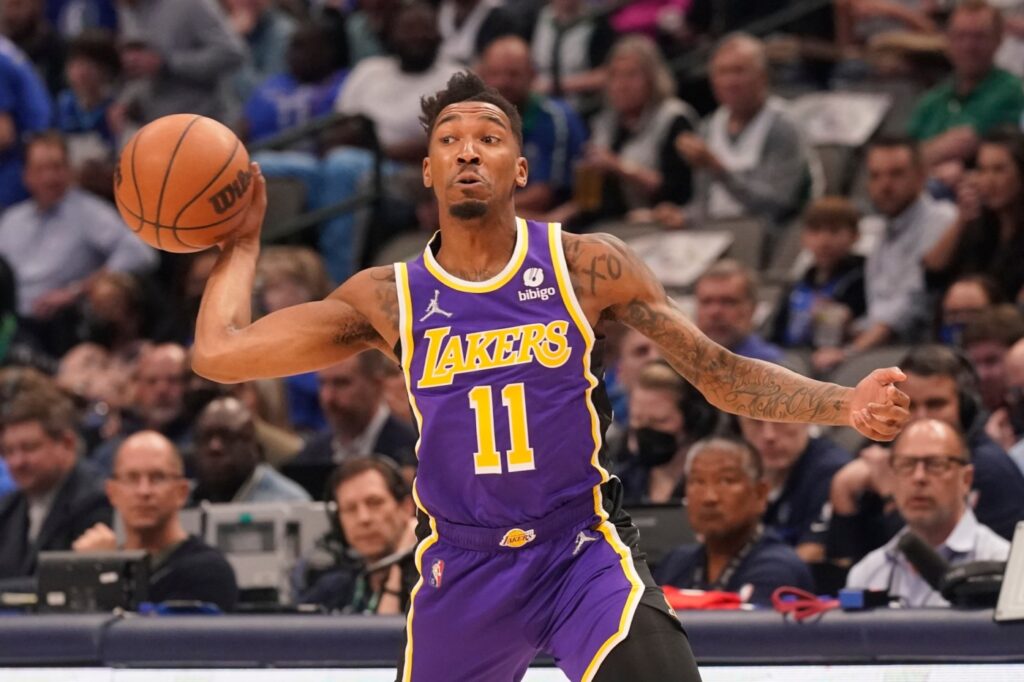
Last season, the Lakers took a chance: They signed Malik Monk, a former lottery pick fallen on hard times, to a minimum deal.
Monk has talked several times about the ache of last summer – hoping for bigger deals before swallowing his pride to come to L.A. at the minimum. It turned out to be a win-win: Monk helped the Lakers absorb a season-long injury to Kendrick Nunn, starting 37 games and averaging 13.8 points as one of the team’s microwave scorers. Playing for the Lakers helped restore Monk’s marketability as he hits free agency again this summer.
Now as the Lakers face a daunting free agency market that many NBA observers have described as especially lean, the franchise finds itself needing to hit on more players like Malik Monk – players who still have untapped potential – while risking losing Monk himself.
Saddled with three max-level contracts, including Russell Westbrook, who opted into his $47.1 million deal on Tuesday, the Lakers have extremely limited resources to fill out a roster with at least six vacancies. The team already has more than $150 million allocated to player salaries, meaning they’ll have only a mid-level exception (about $6.5 million) and veteran’s minimum salaries to offer free agents.
Traditionally, L.A. is a hotbed for free agent players, especially veterans who want to make runs at championship rings. But after that backfired last season, the team’s goals have shifted: toughness, athleticism, shooting – and getting younger. With new coach Darvin Ham in the fold trying to implement a new system on both sides of the ball, General Manager Rob Pelinka emphasized that those qualities will be at a premium.
“I think Darvin is going to prioritize guys who play hard and who compete on every play and compete in the gaps,” Pelinka said after the NBA Draft. “These are the types of players that we’re going to identify in free agency as well. And I do think, of course, having shooting around our three stars is going to be really important to create space.”
But the state of the market makes that an incredible challenge.
Recent trends have seen teams extend players who are already in market, rather than risk them walking away. The conservative moves have already sapped the wing and guard market where the Lakers need the most support, such as Minnesota signing 6-foot-7 wing Taurean Prince to a two-year deal days before free agency begins. Other would-be free agents already have reported commitments (it is well-known that some deals are hashed out before free agency’s June 30th starting bell), such as John Wall to the Clippers, or P.J. Tucker to the Philadelphia 76ers.
The Lakers picked up their team options on Stanley Johnson (6.7 ppg, 3.2 rpg) and Wenyen Gabriel (6.7 ppg, 4.3 rpg) on Wednesday, in part a concession of how difficult the market appears for players at those positions. Both spent chunks of last season in the G League, though Pelinka said both have made strides while working out for the team.
Who is available? Players who fit the Monk mold and could be available: former first-round picks Mo Bamba, Josh Jackson and Josh Okogie, all of whom are still 25 or younger. None are valued offensive assets, but the Lakers are still considering the bulk of the scoring to come from their three highest-paid players.
The team will have a tough decision to make, however, about how to use its midlevel: Do the Lakers attempt to retain Monk, who was a valuable scorer and secondary ball-handler last season, with a $6.5 million offer? Monk indicated in his exit interview in April that he might be willing to return to the Lakers for less money now that he’s found a comfort level in L.A.
Related Articles
Lakers’ Summer League team, highlighted by famous sons, begins practice
Russell Westbrook to opt in to $47.1M contract with Lakers, report says
Reports: Kyrie Irving to exercise $36.5M option, stay with Nets
Kyrie Irving and 4 big questions the Lakers must ask themselves
Lakers GM Rob Pelinka talks Max Christie, Russell Westbrook and more
But could the Lakers use that money to attract a veteran such as Patty Mills, for example, who opted out of his deal in Brooklyn? Or could they make a run at Gary Payton II, who might prove to be too expensive for Golden State to retain due to luxury tax concerns?
Expect, also, the Lakers to be probing the trade market. Last season, the team struggled when Westbrook was paired with Talen Horton-Tucker, the team’s other long-term piece who is under contract for two more seasons. While Horton-Tucker underwhelmed last season (10 ppg, 2.7 apg), he has one of the most tradeable contracts on the team ($10.3 million next season) and is still just 21 years old. So far, the Lakers have been reluctant to send out draft picks in trades, but they’d likely need to in order to make any significant deal.
The Lakers have added youth in the last week, with second-round pick Max Christie, a 19-year-old guard who Pelinka touted as having starting-level talent down the road. They also like Cole Swider and Scotty Pippen Jr., two-way contract players who they hope will have a good showing in Summer League on the road to proving helpful next season.
But within the front office, the Lakers know they have to nail this part of roster-building. Bringing Ham’s system to L.A. will do little without the right players to implement it.
